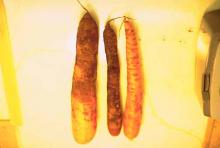Cause Rhizoctonia crocorum (teleomorph: Helicobasidium purpureum, syn. H. brebissonii), a soilborne fungus. In the Pacific Northwest, the disease has been a problem in some carrot fields. The fungus reportedly has a wide host range including asparagus, globe artichoke, alfalfa, bean, beet, cabbage, celery, clover, dandelion, fennel, mangel, parsley, potato, rape, rhubarb, sugar beet, sweet potato, and turnip as well as numerous weed species. It can survive as mycelium or sclerotia in soil or on susceptible crop and weed hosts. The fungus may be spread as a contaminant on seed, plant parts, soil, tools, floodwater, and equipment. The mycelium grows through the soil from plant to plant. Optimum temperature for infection is 59°F to 61°F. The disease is most destructive on heavy, non-limed soils.
Symptoms The disease attacks the plants' underground parts, causing stunting, yellowing, and wilting of aboveground parts or plant death. The fungus produces a loose mat of reddish-purple mycelium over the underground plant portions. Embedded in the mat are numerous small, dark sclerotia. A dry rot occurs, after which secondary organisms may cause a wet rot. A pink-to-brown characteristic mycelial mat may extend along the plant above the soil.
Cultural control
- Use long rotations (4 to 5 years) that include cereals and grasses.
- Provide good weed control and drainage.
- Maintain good fertility, and lime acid soils to increase pH.
Biological control
- Bexfond at 7 to 14 fl oz/A. 4-hr reentry. O

